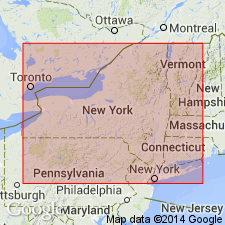
- Usage in publication:
-
- Goat Island member
- Modifications:
-
- Named
- Dominant lithology:
-
- Dolomite
- AAPG geologic province:
-
- Appalachian basin
Summary:
Name Goat Island member of Lockport formation proposed to replace preoccupied name, Suspension Bridge, which was first used for a lower Ordovician formation in New Brunswick, CAN. Goat Island underlies Eramosa member and overlies Gasport limestone member, both of Lockport formation. Age is Middle Silurian (Niagaran).
Source: GNU records (USGS DDS-6; Reston GNULEX).
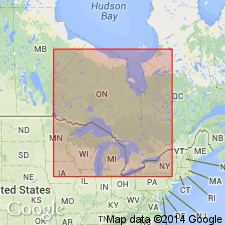
- Usage in publication:
-
- Goat Island member
- Modifications:
-
- Overview
- Dominant lithology:
-
- Dolomite
- AAPG geologic province:
-
- Appalachian basin
Summary:
Goat Island member of Lockport formation described in Niagara Escarpment of Ontario, CAN, as a thick sequence of dolomites. Essentially thick-bedded gray to buff dolomite. Abundant chert nodules and lenses occur at base. Upper limit arbitrarily drawn at first occurrence of bituminous material characteristic of Eramosa member. Maximum thickness 80 ft in Hamilton region.
Source: GNU records (USGS DDS-6; Reston GNULEX).
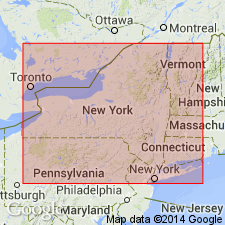
- Usage in publication:
-
- Goat Island Formation
- Modifications:
-
- Revised
- AAPG geologic province:
-
- Appalachian basin
Summary:
Goat Island Formation in subdivided in report area into (ascending) Niagara Falls, Ancaster, and Vinemount Members. Ancaster and Vinemount are extended into NY from their type localities near Hamilton, Ontario. All three members will be formally named by Brett and others (in press: NY State Museum Bulletin). Goat Island overlies the Pekin Member and Gothic Hill Members (also to be named by Brett and others) of the Gasport Limestone and underlies the Eramosa Dolostone, recently extended from CAN to replace the Oak Orchard Member of the Lockport Formation.
Source: GNU records (USGS DDS-6; Reston GNULEX).
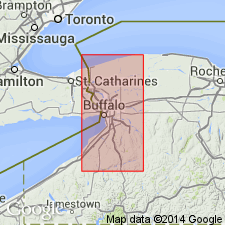
- Usage in publication:
-
- Goat Island Dolomite
- Modifications:
-
- Overview
- AAPG geologic province:
-
- Appalachian basin
Summary:
Lockport Group in this report is considered Late Silurian following Rickard (1975) as the NY Geological Survey does not recognize Middle Silurian as does the USGS. The revisions to the Lockport nomenclature discussed in this report will be formally proposed by C.E. Brett in a larger study of the Niagaran Series. The Lockport Group is divided into the (ascending) Gasport Limestone, the Goat Island Dolomite, the Eramosa Dolomite, and the Guelph Dolomite. The Gasport includes the Gothic Hill and Pekin Members, and the Goat Island includes the Niagara Falls, Ancaster, and Vinemount Members. [Though three of the authors of this report (Tepper, Kappel, and Yager) are USGS scientists, the nomenclature used here has not been officially accepted for use by the USGS.]
Source: GNU records (USGS DDS-6; Reston GNULEX).
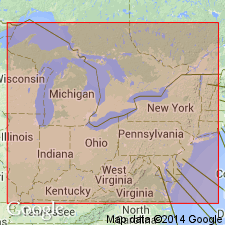
- Usage in publication:
-
- Goat Island Formation
- Modifications:
-
- Age modified
- AAPG geologic province:
-
- Appalachian basin
Summary:
Nomenclature in this report follows Brett and others (in press). Goat Island is divisible into lower Niagara Falls Member, Ancaster Member, and Vinemount Member. Fossil deposit occurring in the middle part of the Lockport Group, midway through the Niagara Falls Member is termed MEDUSAEGRAPTUS epibole. Contains graptoloid graptolites, which are the first ever to be recovered from the Lockport Group and indicate an earliest Ludlovian age. Occurrence of these graptolites indicates the boundary between the Wenlockian and Ludlovian Series in western NY is at or below the base of the Niagara Falls Member. Previously this boundary had been placed much higher in the section.
Source: GNU records (USGS DDS-6; Reston GNULEX).
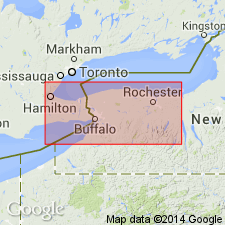
- Usage in publication:
-
- Goat Island Dolomite*
- Modifications:
-
- Revised
- AAPG geologic province:
-
- Appalachian basin
Summary:
The Goat Island Dolomite of the Lockport Group in western NY is revised by the formal naming of three members, (ascending) the Niagara Falls, Ancaster, and Vinemount Members. The Niagara Falls Member is a gray to buff, biohermal grainstone, the Ancaster Member is a buff, thin-bedded, fine-grained, chert-rich dolomite, and the Vinemount Member is a light-gray to black, thin-bedded, shaly dolomite with some chert. Thickness of the Goat Island is 26 to 56 feet and averages 42 feet. Conformably and unconformably overlies the Gasport Dolomite and unconformably underlies the Eramosa Dolomite. East of Brockport, Monroe Co., NY, the Goat Island appears to correlate with the upper part of the Penfield Formation. The Goat Island is probably of Early and Late Silurian (latest Wenlockian and earliest Ludlovian) age based on conodonts. [Silurian time scale of Hartland and others (1982) used in this report.]
Source: GNU records (USGS DDS-6; Reston GNULEX).
For more information, please contact Nancy Stamm, Geologic Names Committee Secretary.
Asterisk (*) indicates published by U.S. Geological Survey authors.
"No current usage" (†) implies that a name has been abandoned or has fallen into disuse. Former usage and, if known, replacement name given in parentheses ( ).
Slash (/) indicates name conflicts with nomenclatural guidelines (CSN, 1933; ACSN, 1961, 1970; NACSN, 1983, 2005, 2021). May be explained within brackets ([ ]).

